#peirosauridae
Explore tagged Tumblr posts
Text
Croc Paleontology Recap January 2025
The year has just begun and already we got a bunch of pretty neat new studies on fossil pseudosuchians so I'll just briefly go over them and unless I forget or end up procrastinating/getting too busy I'll hopefully be able to keep this going throughout the rest of the year.
Just to give you a brief overview, the highlights of this month include: salt glands in gavialoids, crocodilian predation on azhdarchids, diversifications and extinctions in thalattosuchians and a new species of aetoaur from India. Lets begin.
Evidence for salt glands in gavialoids
Starting off with something relating to the dispersal of gavialoids, we got "Evaluation of the endocranial anatomy of the early Paleogene north African gavialoid crocodylian Argochampsa krebsi and evolutionary implications for adaptation to salinity tolerance in marine crocodyliforms" by Pliggersdorfer, Burke and Mannion.
The title already gives a lot away, but the point was that Argochampsa, from the early Paleocene Ouled Abdoun Basin in Morocco, was examined for evidence of salt tolerance. Why? Because the dispersal of gavialoids remains weird. Both modern forms aren't especially keen on saltwater and are only known to consistently occur in freshwater (tho we have a recent example of an indian gharial caught in a fishing net off the coast of India), yet we have plenty of extinct gavialoids that either indicate that the group must have crossed oceans (see any "gryposuchine") or straight up lived at sea (also see some "gryposuchines").
Now, one such example might also be Argochampsa. Both because the Ouled Abdoul Basin famously preserves coastal deposits and because, at least following some phylogenies, Argochampsa might be closely related to the gharials of South America and today (others say its not even a gavialoid but lets ignore that for now). So all things considered one might expect marine habits from Argochampsa, yet so far no such adaptations could be identified. Well, Pliggersdorfer and co. analyzed a thus-far undescribed skull and actually managed to find something. Small depressions on the inside of the skull are suspiciously similar to ones seen in the extinct, fully marine metriorhynchoids, depressions that in the latter have been interpreted as having been left by salt glands. There is also some further evidence through the morphology of the inner ear.
This conclusion further extends to a handfull of other taxa, including the dyrosaurid Rhabdognathus and the recently named gavialoid Sutekhsuchus, and lends itself to the hypothesis that salt glands may have been ancestral to gavialoids, something I personally find unsurprising given their proximity to crocodyloids and their dispersal across the world (really if anything alligatoroids seem like the odd one out).
Fun fact, yours truly is featured in the paper in the form of two silhouettes.
Left: Argochampsa, illustrated by Seismic Shrimp/JW Right: Piscogavialis, perhaps the most famous marine gavialoid, illustrated by Joschua Knüppe

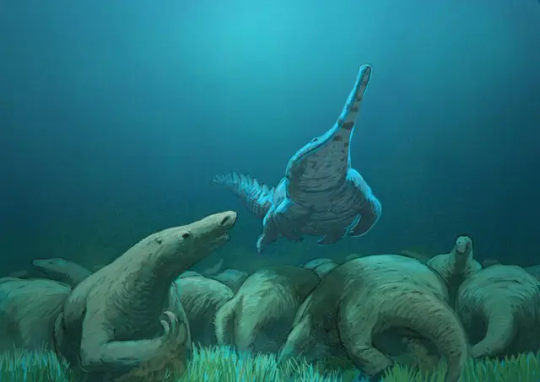
The brain of Paralligator
Second on our neat little list, the neuroanatomy of Paralligator, studied through CT scans and 3D modeling and published on in "Neurocranial anatomy of Paralligator (Neosuchia: Paralligatoridae) from the Upper Cretaceous of Mongolia". Given that I am not great with brain things, I'll keep this one short.
Now for those unfamiliar, Paralligator is part of a somewhat strange clade known as the Paralligatoridae, which contrary to their name are nowhere near real alligators (tho some do look deceptively similar). Instead, they are much more basal members of Eusuchia.
Measurements of the olfactory bulbs, responsible for the sense of smell, indicate that in Paralligator this sense was similarily developed to allodaposuchids and crocodilians, as is the inner ear who's anatomy suggests a semi-aquatic lifestyle. Paralligator does however differ in possessing a mesothemoid, a bony septum in the olfactory region that is also seen in dyrosaurids, baurusuchids and dinosaurs, but not modern crocodiles.

Borealosuchus remains from Colorado
Tho seemingly unexciting, this study, "First record of Borealosuchus sternbergii from thelower Paleocene Denver Formation (lower Danian),Colorado (Denver Basin)" actually helps us fill a neat little gap in our previous knowledge on croc survival across the Cretaceous-Paleocene extinction.
Simply put, though America's croc record across the KPG is rather remarkable, showing both many survivors and some incredible diversification after the impact, Colorado is kind of a blind spot, despite its potential importance. Perhaps one of the best examples of a survivor concerns the genus Borealosuchus, which is both geographically and stratigraphically widespread. To put things into perspective, this genus occured as far north as Canada and as far south as Texas, first appearing in the Late Cretaceous and dying out in the Eocene.
This paper now described several skulls from the Corall Bluff's locality of the Denver Formation, earliest Paleocene, that can be attributed to Borealosuchus sternbergii, definitively extending its range beyond KPG (granted, there are tentatively referred Paleocene occurences elsewhere), making it one of the largest suvivors of the mass extinction, with adults growing up to 2.3 meter in length. The specimens from Colorado are smaller, in the 1.5 to 1.7 meter range, but they are also regarded as immature individuals and are therefore also regarded as usefull in illustrating how the animals changed as they grew into adulthood.
This paper is especially well timed for those that follow @knuppitalism-with-ue 's Formation Stream series. As you might know, Corall Bluffs is to be drawn barely a week from now and this is a fantastic addition.
Left: Borealosuchus drawn by Atak_Draws Right: Distribution of Borealosuchus by Lessner, Petermann and Lyson 2025
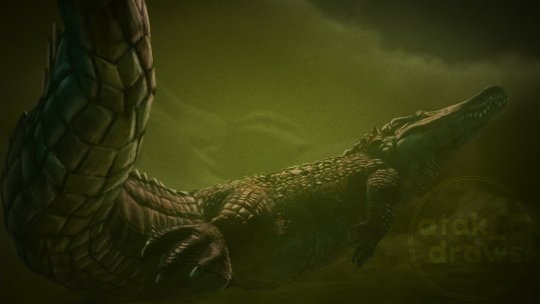

Growth of a peirosaur
Our next paper for discussion is "Life history and growth dynamics of a peirosaurid crocodylomorph (Mesoeucrocodylia; Notosuchia) from the Late Cretaceous of Argentina inferred from its bone histology" by Tamara G. Navarro and colleagues. This study conducted the first histology of peirosaurid limb bones, specifically of an indetermined taxon clading together with Uberabasuchus.
As a brief refresher, peirosaurids are a branch of medium to large sized Notosuchians that I personally think can be aptly described as appearing somewhat like scaly dogs or pigs with often robust, wedge-shaped heads and heavily armored bodies.
The results show that the animal had reached sexual maturity, yet was not yet fully grown. What's also noted is the exact growth dynamics of this animal. This is to say, the studied peirosaurid had overall slow growth with cycles of no growth whatsoever and two periods of increased growth, tho once put against other notosuchians the study deems the growth rates to be better described as "moderate". Pepesuchus meanwhile, belonging to the closely related itasuchids, was a fast grower. Extending things beyond their shared clade shows a virtual mish-mash of dynamics, with Araripesuchus buitreraensis displaying slow growth rates (yet Araripesuchus wegeneri having faster rates than the peirosaur), Iberosuchus showing slow rates, and Notosuchus displaying high growth rates (hell, theres even variation between individuals). A final point concerns the age of the individual, which is....contradictory. Based on the limb bones, the study estimates that the animal was at the very least 15 years old, but previous study of the osteoderms has yielded an estimated age of 18 years old. Ultimately, further study is needed, but it does clearly show how the histology of different parts of the skeleton varies.
Shown below, Uberabasuchus terrificus by Scott Reid

Predation on pterosaurs
Here's a fun one, "A juvenile pterosaur vertebra with putative crocodilian bite from the Campanian of Alberta, Canada", once again with a name that tells you very much what you're in for.
Brown and colleagues report on the discovery of a juvenile specimen of the azhdarchid Cryodrakon from the Dinosaur Park Formation of Alberta, Canada. The neck vertebra bears some conical bite marks, notably different from those of theropods, which generally have D-shaped or compressed tooth crosssections (sans spinosaurids, which aren't present). Champsosaurus is also ruled out due to its inferred feeding preferences, weak bite force and slender teeth. Mammals are potential candidates, but the team regards it as more likely that the trace maker was a crocodilian. Considering the fauna of the Dinosaur Park Formation, this would suggest the culprit was either Leidyosuchus, Albertochampsa or an animal described as "Stangerochampsa-like".
Now this is a very interesting, if not exactly unexpected interaction. On the one hand, having direct fossil evidence for this is a big deal, even if we don't know if the bite marks were left due to the pterosaur being actively hunted or if they were simply left when a lucky croc came across the carcass of an already deceased Cryodrakon. On the other hand, crocodiles and kin are notoriously opportunistic and broad in their diet, so one feeding on a pterosaur is something that seems like a no-brainer in principle, especially a relatively small individual with a wingspan of "only" 2 meters. This is further supported by the fact that crocodilian bite marks have also been reported from the Romanian pterosaur Eurazhdarcho.
Obvious difference in prey size and geography aside (and taxon names even within the chosen setting while we're on it), Prehistoric Planet really nailed the nailon the head with this one.
In the left corner, a juvenile Cryodrakton (art by Hank Sharpe). In the right corner, Leidyosuchus (art by Gunnar Bivens) LET THEM FIGHT (or scavenge)


Evolutionary trends and extinctions in Thalattosuchia
This one's a last minute entry, by which I mean this one got just published as I was about to wrap this whole thing up. "Analysing Thalattosuchia palaeobiodiversity through the prism of phylogenetic comparative methods" explores how the evolution and the extinctions of members of this group were shaped by both biotic and abiotic factors.
Given the shere breadth of this topic, a quick summary of thalattosuchia seems kinda in order. In short, thalattosuchians are a group of what are likely to be early crocodyliforms adapted to life at sea. They can be split into two groups, the teleosauroids, superficially gharial like animals that likely stuck to coastal waters, and the metriorhynchoids, open ocean animals with fluked tails, no body armor and paddle-like limbs. Both groups reached their greatest diversity in the late Jurassic, but managed to survive into the Cretaceous before disappearing entirely.
The study recaps that thalattosuchians first reach great diversity during the Toarcian, tho this is likely influenced by preservation bias thanks to Lagerstätten such as the Posidonia shale, and a later diversification takes place during the Bathonian. Regardless, the transition from the lower to middle Jurassic sees an increased trend in both thalattosuchian groups towards shorter snouts, which are associated with durophagy or hypercarnivory. This essentially gives rise to the teleosauroids of the Machimosaurinaei, which appear during the Bathonian and have blunt, robust teeth, as well as the metriorhynchoid Geosaurinae, which appeared at the same time and had ziphodont (serrated teeth). The reasons for this could be twofold. On the one hand, thalattosuchians were very abundant, so expanding into new nisches helped them coexist, with ecosystems preserving fish-eaters, hypercarnivores, durophages and more at the same time. More of an underlying factor could be a drop in ichthyosaur diversity, leaving plenty of open nisches for these crocs to fill.
Subsequently, during the transition from the Middle to Late Jurassic, there was another diversification event with both groups establishing new major clades, possibly associated with the warm temperatures of the Late Jurassic, before the diversity crashes with the onset of the Cretaceous. The authors note that this too might have been related to climate, with the Cretaceous survivors mostly being found in warmer waters.
Left: A Dakosaurus ambushing an ichthyosaur by Gabriel Ugueto Right: A large Machimosaurus rests on the beach as a sauropod approaches, art by Joschua Knüppe
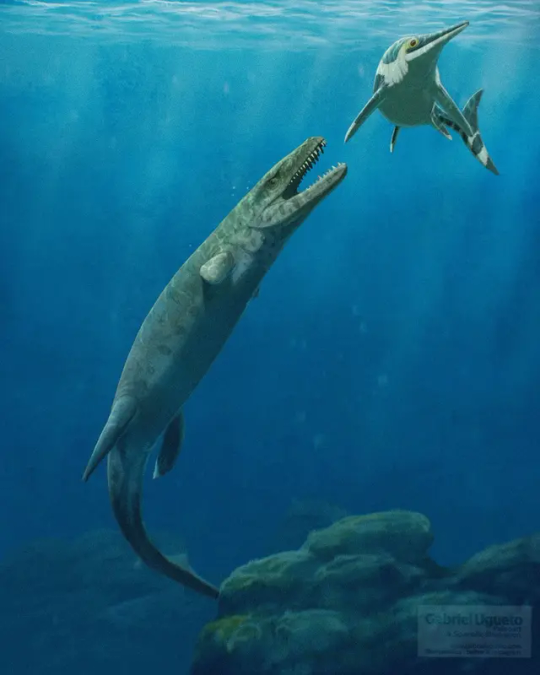
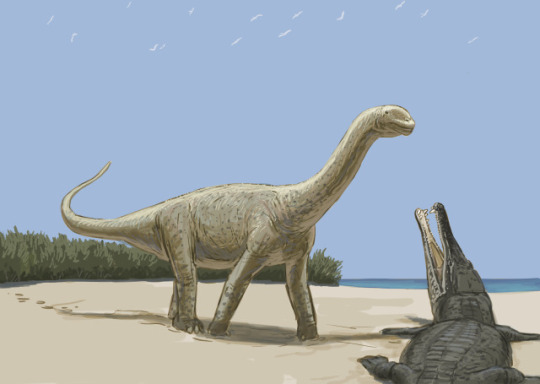
and for the final study I wanna talk about
Kuttysuchus: A new Aetosaur from India
Now, by all accounts one might be surprised to see this just kinda thrown in at the end here rather than getting a dedicated post as I usually like to do with new forms. And truth be told, theres just not that much to say about "A New paratypothoracin aetosaur (Archosauria: Pseudosuchia) from the Upper Triassic Dharmaram Formation of India and its biostratigraphic implications".
Kuttysuchus is our first pseudosuchian to be described this year and to get things out of the way, its not super exciting in terms of material. Like some other recently named aetosaurs, Kuttysuchus is based entirely on a handfull of osteoderms. And there's nothing wrong with that, after all osteoderms are rather distinctive for these animals. It does however mean that the information we can get from them is a bit limited and thus makes it hard to really put together something engaging.
More interesting than the anatomy then is the range and its relationship to other aetosaurs. The fossils are known from the Dharmaram Formation of India, which you might recall is also home to the recently named Venkatasuchus. Both Venkatasuchus and Kuttysuchus are members of the Paratypothoracini, tho the former is significantly more derived and the latter more basal.
Fossil osteoderms of Kuttysuchus, all belonging to the central double row that stretches across the back.
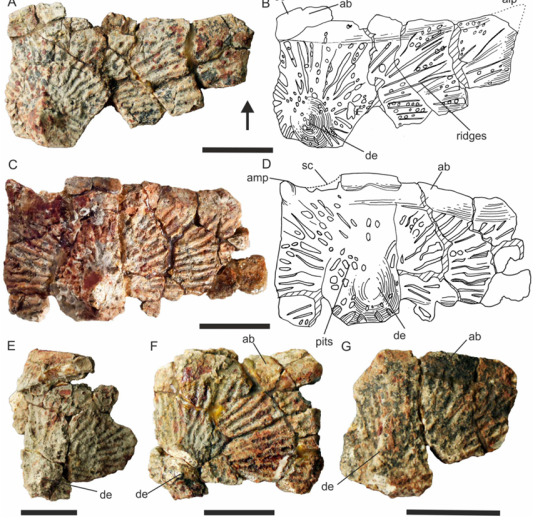
I'll be entirely honest. This was a lot more work to type out than anticipated, but admittedly also fairly rewarding. Hopefully you dear reader found it equally interesting, and hey, congrats on making it to the end.
#palaeoblr#paleontology#prehistory#croc#crocodile#long post#pseudosuchia#sutekhsuchus#argochampsa#peirosauridae#thalattosuchia#metriorhynchoidea#teleosauroidea#kuttysuchus#aetosauria#paralligator#leidyosuchus#cryodrakon#borealosuchus
141 notes
·
View notes
Text

Croctober day 17:
Hamadaduchus
#hamadasuchus#croctober#croctoberart#pseudosuchia#cretaceous#notosuchia#sebecia#peirosauridae#paleoart
22 notes
·
View notes
Text

A new species of Araripesuchus with durophagous dentition increases the ecological disparity among uruguaysuchid crocodyliforms
María Lucila Fernández Dumonta, Diego Pol, Paula Bona &Sebastián Apesteguía
Abstract
Notosuchia is a group of crocodyliforms with mostly terrestrial habits that lived during the Mesozoic and up to the Miocene. Within this group Uruguaysuchidae is so far represented by eight species, six of them clustered in the genus Araripesuchus. Two species of this genus, A. patagonicus and A. buitreraensis, come from different localities in Patagonia (Argentina) from the Candeleros Formation (Cenomanian age). Here we present a third species of Araripesuchus from this formation. The new species comes from the same locality as Araripesuchus buitreraensis, but differs in numerous features including the presence of different molariform teeth. The new species was included in a phylogenetic analysis and, in agreement with previous analyses, Uruguaysuchidae is recovered as monophyletic and placed within Notosuchia as the sister clade of Peirosauridae. Uruguaysuchidae includes all species of Araripesuchus as well as Anatosuchus minor and Uruguaysuchus aznarezi. The new species adds new information to the ecological diversity of the group its bulbous molariforms with a quadrangular occlusal surface bounded by mamelons is interpreted as indicative of a durophagous diet, suggesting the presence of niche partitioning between the two sympatric species A. manzanensis and A. buitreraensis.
Read the paper here:
A new species of Araripesuchus with durophagous dentition increases the ecological disparity among uruguaysuchid crocodyliforms: Journal of Systematic Palaeontology: Vol 22 , No 1 - Get Access (tandfonline.com)
#prehistoric#paleontology#reptile#herpetology#crocodilian#crocodyloform#animals#nature#south america#notosuchia
170 notes
·
View notes
Text
Identificata una nuova specie di Gondwanan notosuchian in Brasile
Epoidesuchus tavaresae è una nuova specie di Peirosauridae del Cretaceo della Formazione Adamantina in Brasile. I paleontologi hanno descritto un nuovo genere e una nuova specie di notosuchiano dal resto frammentario trovato nella Formazione Adamantina del Brasile. Epoidesuchus tavaresae abitava l’antico supercontinente Gondwana durante il tardo Cretaceo, circa 72 milioni di anni fa. L’antico…

View On WordPress
0 notes
Photo

Montealtosuchus arrudacamposi, a crocodyliform from the Late Cretaceous of Brazil (~93-83 mya). About 1.8m in length (6′), it had slightly forward-facing eyes, giving it binocular vision, and long upright limbs -- adaptations for active hunting on land.
Basically, it would have looked a little like a “crocodile dog”.
#science illustration#paleontology#paleoart#palaeoblr#montealtosuchus#peirosauridae#crocodyliformes#crocodylomorph#pseudosuchia#archosaur#art#crocodog#i'll take ten
176 notes
·
View notes
Text
Some entries for @knuppitalism-with-ue 's most recent spec evo challenge, Lemuria. I kinda went a lot into sauropods, but will try to steer more into Notosuchia from here on out.


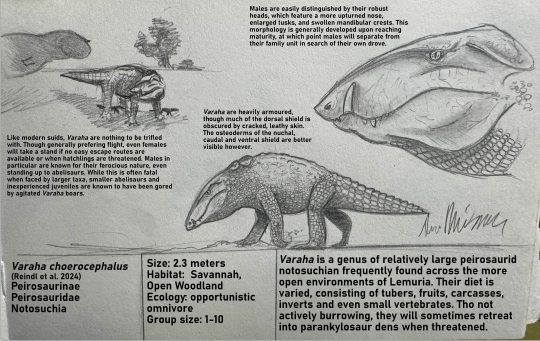
The current entries consist of 1) a small monogamous rainforest sauropod 2) a large solitary desert wanderer 3) a hippo-like swamp dweller 4) an aggressive native of the mountains 5) a pig-like peirosaurid
#spec evo#titanosaur#peirosauridae#notosuchia#sauropod#speculative evolution#speculative biology#lemuria#lemuriachallenge#paleostream
85 notes
·
View notes
Text
Large caimans, seacow predation and a new pepesuchine
What a week we just had when it comes to fossil crocodile news. Not one, not two, but three whole publications dropped this last week, each noteworthy in its own way.
The first of these was "New taxa of giant caimans from the southernmost hyperdiverse wetlands of the South American late Miocene", which coined two new genera of caiman from the Argentinian Ituzaingó Formation.
Tho the names are new, both are far from unknown. The first of these is Paranacaiman bravardi, which was described based on a fossil traditionally associated with Caiman lutescens (now deemd a nomen dubium). The second is Paranasuchus gasparinae, which was already described in 2013 under the name Caiman gasparinae.
I will say that I find the names to be a little poorly chosen. On its own either one works, but together they are very similar and feel like they might cause some confusion down the line, at least in science communication.
But that's just my own opinion. Regardless of nomenclature, they are interesting. I am currently working on reconstructing Paranasuchus, but I did wrap up Paranacaiman with a simple reconstruction of the skull and a quick scaling, revealing it to have potentially been just shy of five meters in length.


Barely a day later we got hit with more Miocene croc news, specifically a short note on crocodilian feeding traces being identified on the fossils of the dugong Culebratherium from Venezuela. The animal has bitemarks all over its body, but highlighted are those centered around the skull. In addition to simple punctures, some bitemarks appear to showcase dragging and slashing, possibly associated with the well known deathroll performed my crocs. Alltogether, this could hint at the fact that one of the large crocodilians of the Agua Clara Formation might have grasped the seacow by its snout to drown it before tearing into it. Given that the fossil locality is fairly new and the fact that they are nothing but bite marks, we do not know what crocodilian was responsible, tho the paper suggests a small to medium sized caiman. Feeding traces also show that tiger sharks got involved at some point, which mirrors fossil evidence from the Austrian Paratethys.
Artwork of the possible predation event by Jaime Bran

And the final croc paper of last week takes us back quite a bit further, all the way back to the Cretaceous. Epoidesuchus tavaresae is a new species and genus of pepesuchine peirosaurid from the Adamantina Formation of Brazil, famous for its diversity of notosuchians (and apparent lack of modern crocs sans one exception).
Now for those unfamiliar, Pepesuchinae is a subfamily of Peirosaurids, best recognized by having slender, very crocodilian-like jaws that may indicate more semi-aquatic habits, as opposed to the more terrestrial and almost pig-like peirosaurines such as Uberabasuchus.
I should mention that theres some debate around the nomenclature. The paper follows the idea that Pepesuchinae is a subfamily of Peirosauridae, but a more recent paper (which at least two of the authors including the lead worked on) has Peirosaurinae and Pepesuchinae both as fully-fledged families, with the latter going by the name Itasuchidae (which is the older name). I should further mention that the nomenclature paper coined the clade Peirosauria to contain both these families and Mahajangasuchidae.
Anyways, tho fragmentary, we know that Epoidesuchus had the same narrow jaws as many other pepesuchines/itasuchids and was likely semi-aquatic. Given that neosuchians are rarer in South America, it seems very possible that their nische was largely filled by these specialised notosuchians, which strayed from the usual terrestrial habits of their group. In fact, tho many different notosuchians are known from the Bauru Group, the only neosuchian recovered so far is the recently named Titanochampsa.
Below the gorgeous press art by Guilherme Gehr

All three papers in order
New taxa of giant caimans from the southernmost hyperdiverse wetlands of the South American late Miocene: Journal of Systematic Palaeontology: Vol 22 , No 1 - Get Access (tandfonline.com)
Full article: Trophic interactions of sharks and crocodylians with a sea cow (Sirenia) from the Miocene of Venezuela (tandfonline.com)
A new Peirosauridae (Crocodyliformes, Notosuchia) from the Adamantina Formation (Bauru Group, Late Cretaceous), with a revised phylogenetic analysis of Sebecia - Ruiz - The Anatomical Record - Wiley Online Library
#crocs#crocodilia#notosuchia#caimaninae#paranacaiman#paranasuchus#caiman gasparinae#caiman lutescens#epoidesuchus#pepesuchinae#itasuchidae#peirosauridae#culebratherium#south america#miocene#cretaceous#fossils#paleontology#prehistory#palaeoblr#long post#paleontology news#pseudosuchia
43 notes
·
View notes